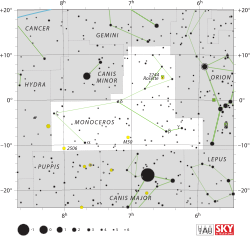- Monoceros
-
Monoceros Constellation 
List of stars in MonocerosAbbreviation Mon Genitive Monocerotis Pronunciation /məˈnɒsɨrəs/, genitive /ˌmɒnəsɨˈroʊtɨs/ Symbolism the Unicorn Right ascension 7.15 h Declination −5.74° Quadrant NQ2 Area 482 sq. deg. (35th) Main stars 4 Bayer/Flamsteed
stars32 Stars with planets 16 Stars brighter than 3.00m 0 Stars within 10.00 pc (32.62 ly) 2 Brightest star β Mon (3.76m) Nearest star Ross 614
(13.3 ly, 4.09 pc)Messier objects 1 Meteor showers December Monocerids
Alpha MonoceridsBordering
constellationsCanis Major
Canis Minor
Gemini
Hydra
Lepus
Orion
PuppisVisible at latitudes between +75° and −90°.
Best visible at 21:00 (9 p.m.) during the month of February.Monoceros (Greek: Μονόκερως) is a faint constellation on the celestial equator. Its name is Greek for unicorn. Its definition is attributed to the 17th-century Dutch cartographer Petrus Plancius. It is bordered by Orion to the west, Gemini to the north, Canis Major to the south and Hydra to the east. Other bordering constellations include Canis Minor, Lepus and Puppis.
Contents
Notable features
Stars
Monoceros is a constellation that is not very easily seen with the naked eye, with only a few fourth magnitude stars. Alpha Monocerotis has a visual magnitude of 3.93, slightly brighter than Gamma Monocerotis at 3.98.
However, Monoceros does have some interesting features to observe with the aid of a small telescope. Beta Monocerotis is an impressive triple star system, the three stars forming a triangle which seems to be fixed. The visual magnitudes of the stars are 4.7, 5.2 and 6.1. William Herschel discovered it in 1781 and commented that it is "one of the most beautiful sights in the heavens".
Epsilon Monocerotis is a fixed binary, with visual magnitudes of 4.5 and 6.5.
S Monocerotis, or 15 Monocerotis, is a bluish white variable star and is located at the center of NGC 2264. The variation in its magnitude is slight (4.2–4.6). It has a companion star of visual magnitude 8.
V838 Monocerotis had an outburst starting on January 6, 2002.
Monoceros also contains Plaskett's Star, which is a massive binary system whose combined mass is estimated to be that of almost 100 Suns put together.
Planets
Monoceros contains two super-Earth exoplanets in one planetary system: COROT-7b was detected by the COROT satellite and COROT-7c was detected by HARPS from ground-based telescopes. COROT-7b has the smallest known radius of any known exoplanet, 1.7 Earth radii. Both planets in this system were discovered in 2009.
Deep sky objects
Monoceros contains many clusters and nebulae, most notable among them:
- M50, an open cluster
- The Rosette Nebula (NGC 2237-9,46), a diffuse nebula
- The Christmas Tree Cluster and associated Cone Nebula (NGC 2264)
History
Monoceros is a relatively modern constellation. Its first certain appearance was on a globe created by the Dutch cartographer Petrus Plancius in 1612 or 1613[1] and it was later charted by Jakob Bartsch as Unicornus in his star chart of 1624.
Heinrich Wilhelm Olbers and Ludwig Ideler[2] indicate (according to Richard Hinkley Allen's allegations) that the constellation may be older, quoting an astrological work[3] from 1564 that mentioned "the second horse between the Twins and the Crab has many stars, but not very bright"; these references may ultimately be due to Michael Scot of the 13th century, but refer to a horse and not a unicorn, and its position does not quite match. Joseph Scaliger is reported[4] to have found Monoceros on an ancient Persian sphere.
Citations
- ^ Le costellazioni di Petrus Plancius on atlascoelestis.com
- ^ Ideler, Ludwig (1809). Untersuchungen über den Ursprung und die Bedeutung der Sternnamen: Ein Beytrag zur Geschichte des gestirnten Himmels. Berlin. pp. 354..355. freely available HERE
- ^ Himmels Lauffs Wirkung und natürliche Influenz der Planeten Gestirne und Zeichen aufs Grund der Astronomie. Frankfurt. 1564.
- ^ Allen, Richard Hinckley (1899). Star Names - their lore and meaning, online link. Dover. p. 290.
References
- Ridpath, Ian; Wil Tirion (2007). Stars and Planets Guide. London: Collins. ISBN 978-0-00-725120-9. Princeton: Princeton University Press. ISBN 978-0691135564.
External links
- VISTA Reveals the Secret of the Unicorn — ESO Photo Release
- The Deep Photographic Guide to the Constellations: Monoceros
- The Constellations Web Page - Monoceros
- Star Tales – Monoceros
Andromeda · Antlia · Apus · Aquarius · Aquila · Ara · Aries · Auriga · Boötes · Caelum · Camelopardalis · Cancer · Canes Venatici · Canis Major · Canis Minor · Capricornus · Carina · Cassiopeia · Centaurus · Cepheus · Cetus · Chamaeleon · Circinus · Columba · Coma Berenices · Corona Australis · Corona Borealis · Corvus · Crater · Crux · Cygnus · Delphinus · Dorado · Draco · Equuleus · Eridanus · Fornax · Gemini · Grus · Hercules · Horologium · Hydra · Hydrus · Indus · Lacerta · Leo · Leo Minor · Lepus · Libra · Lupus · Lynx · Lyra · Mensa · Microscopium · Monoceros · Musca · Norma · Octans · Ophiuchus · Orion · Pavo · Pegasus · Perseus · Phoenix · Pictor · Pisces · Piscis Austrinus · Puppis · Pyxis · Reticulum · Sagitta · Sagittarius · Scorpius · Sculptor · Scutum · Serpens · Sextans · Taurus · Telescopium · Triangulum · Triangulum Australe · Tucana · Ursa Major · Ursa Minor · Vela · Virgo · Volans · VulpeculaFlamsteed 1 • 2 • 3 • 5 (γ) • 6 • 7 • 8 (ε) • 9 • 10 • 11 (β) • 12 • 13 • 14 • 15 • 16 • 17 • 18 • 19 • 20 • 21 • 22 (δ) • 24 • 25 • 26 (α) • 27 • 28 • 29 (ζ) • 77 Ori • 78 OriNearby Other Categories:- Monoceros constellation
- Constellations
- Southern constellations
- Eastern constellations
Wikimedia Foundation. 2010.
